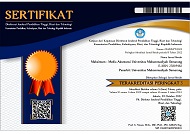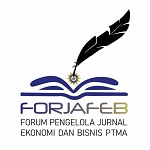Praktek Kecurangan (Fraud) dan Modusnya di Lingkungan Usaha PT JOY
(1) Universitas Jayabaya Jakarta
(2) Universitas Jayabaya Jakarta
(*) Corresponding Author
Abstract
Keywords
Full Text:
PDFReferences
ACFE. (2008). Fraud Examiners Manual. ACFE.
Akuh, C. G. (2017). Small Retail Business Strategies to Detect and Prevent Employee Fraud. ProQuest Dissertations and Theses.
Albrecht, W. S., Albrecht, C. O., Albrecht, C. C., & Zimbelman, M. F. (2012). Fraud Examination. South-Western Cengage Learning. https://doi.org/10.1017/CBO9781107415324.004
Callen, J. L., Robb, S. W. G., & Segal, D. (2008). Revenue manipulation and restatements by loss firms. Auditing. https://doi.org/10.2308/aud.2008.27.2.1
Dewi, R., & Apandi, N. N. (2012). Gejala Fraud Dan Peran Auditor Internal Dalam Pendeteksian Fraud Di Lingkungan Perguruan Tinggi. SNA XV Banjarmasin.
Gee, S. (2014). Fraud Detection. In Fraud and Fraud Detection. https://doi.org/10.1002/9781118936764.ch2
IAI. (2011). SA Seksi 220. Standar Auditing.
Karyono. (2017). Forensic Fraud. Yogyakarta: CV. Andi. In cv. Andi.
Nawawi, A., & Salin, A. S. A. P. (2018). Employee fraud and misconduct: empirical evidence from a telecommunication company. Information and Computer Security. https://doi.org/10.1108/ICS-07-2017-0046
Omar, M., Nawawi, A., & Salin, A. S. A. P. (2016). The causes, impact and prevention of employee fraud: A case study of an automotive company. Journal of Financial Crime. https://doi.org/10.1108/JFC-04-2015-0020
Safuan; Ismartaya; Budiandru. (2021). Fraud dalam Perspektif Islam. 5, 219–228.
Safuan. (2018). FRAUD AND ANTI-FRAUD IN THE PORT SECTOR. Asia Pasific Fraud Journal, 3, 145– 152. https://doi.org/10.21532/apfj.001.18.03.01.17
Safuan, Budiandru, Arief, R. K., & Adesta, E. Y. T. (2020). Web based e-catalog implementation at TPK-KOJA: Case study of stock inventory division. International Journal of Advanced Science and Technology, 29(7), 481–488. Retrieved from https://www.scopus.com/inward/record.uri?eid=2-s2.0-85085053764&partnerID=40&md5=b09d8e825d36e62062d62da69ad355f8
Sauser, W. I. (2007). Employee Theft: Who, How, Why, and What Can Be Done. SAM Advanced Management Journal.
Sawyer, L. B. (2003). Sawyer’s Internal Auditing: The Practice of Modern Internal Auditing. The Institute of Internal Auditors.
Article Metrics
Abstract view : 788 timesPDF - 11 times
DOI: https://doi.org/10.26714/mki.11.1.2021.43-49
Refbacks
- There are currently no refbacks.
-----------------------------------------------------------------------------------------------------------------------------------------------------------------------------------
 | MAKSIMUM: Media Akuntansi Universitas Muhammadiyah Semarang |
![]()
Maksimum: Media Akuntansi Universitas Muhammadiyah Semarang is licensed under a Creative Commons Attribution Attribution-NonCommercial-NoDerivatives 4.0 International License.

















